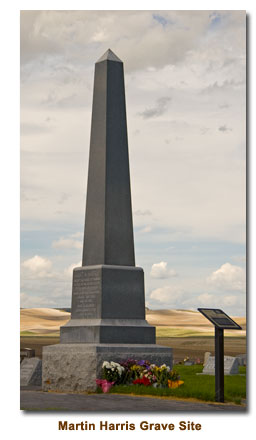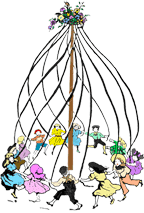Early History of Clarkston, 1864 to 1867
Clarkston was settled in the fall of 1864, and resettled in the year 1867. Among the first settlers were Israel J. Clark, James Myler, Wiliam Ricks, Michael Poulsen, Johannis Dahle, Gideon Harmison, David Cook, John Griffiths, John Griffin, John Godfrey, Samuel Whitney, Ola S. Jensen and families; also the Thompson and Hansen families, A. W. Heggie, a Mr. Parker, Paul Paulson, Andrew McCombs, Simon Smith, Isaac Cook, A. N. Atkinson and others.
At first the settlers began to build on what is known as the flat, just east of where Clarkston is now situated. The water was not so good at this place and as there was some sickness, President Brigham Young advised the settlers to move the settlement upon the higher land nearer the head of City Creek and the other springs.
Mr. Israel J. Clark built the first log house two blocks east of the present school building. Here the first school was held and Betsy Clark, wife of Israel Clark, was the first schoolteacher. Israel J. Clark was the first bishop of Clarkston and Apostle Ezra T. Benson organized the ward and named the settlement after Mr. Clark. Mr. Clark was also an Indian interpreter and was called to Logan many times to act in this capacity.
Because of the Indian troubles in other parts of the Valley and the rather dangerous position which Clarkston occupied because of being so far away from the other settlements, all the settlers moved away in the spring of 1866 to Smithfield, Logan and other places in the Valley. Some moved away from the Valley entirely. Indian John, who was a chief under that great old chief, Washakie, claimed all the land west of the Bear River and included all the Clarkston area. He demanded one hundred and fifty beeves and a lot of flour, but finally a settlement was made for a few beeves and several hundred pounds of flour for the land.
In 1867 the settlers desired to return to their homes in Clarkston and President Brigham Young advised them they might do so providing they would build a fort and public corral for their protection and that of their stock. The houses were therefore built in the form of a fort on both sides of the present Main Street and a public corral was provided.
Clarkston had extremely heavy winters and the snow drifted and covered everything. It was suggested that the settlement be abandoned and relocated or moved to where the present site of Newton is. It was believed the snow would not drift so much at this place and it would be a better place to have a settlement. As a result, quite a number moved to where Newton is. It had already been surveyed by County Surveyor James H. Martineau and was ready to be occupied and was considered a good place for a settlement.
As there was not so much water at the Newton site as at Clarkston and for other reasons, a division arose among the settlers as to which place should become know as Clarkston. Some remained at Clarkston and determined to stay there and have that Clarkston, while others who had moved to where Newton is, form Clarkston and other places, determined to have that place named Clarkston. There was quite a contention and President Brigham Young held meetings in both places and went over the arguments of the people very carefully. He also looked into the water supply of both places and the general physical conditions. He decided that those who desired to remain at the Newton site should do so and those who desired to remain at Clarkston should do so, and make two settlements. Clarkston, therefore, remained in its original place; however, some who moved to Newton from Clarkston remained there.
 At Clarkston, the city lots were laid off and the land surveyed by James H. Martineau, the county surveyor. Bishop Israel J. Clark gave out the lots and the farming land to the settlers. Ten acres of land were given to a single man, while twenty acres were given to a married man. Small irrigation streams from the Clarkston Creek and other springs were made, and from this they were able to grow some crops. At this time dry farming was not thought of; however, President Brigham Young predicted that all the dry land area north, would grow much grain on this land. A few years later the settlers kept experimenting with different grains on the dry land and finally they succeeded in getting a seed that would mature. At the present time the Clarkston area is one of the best dry sections of the county or the state. One of the old pioneer dry land farmers in Clarkston was Samuel A. Whitney.
At Clarkston, the city lots were laid off and the land surveyed by James H. Martineau, the county surveyor. Bishop Israel J. Clark gave out the lots and the farming land to the settlers. Ten acres of land were given to a single man, while twenty acres were given to a married man. Small irrigation streams from the Clarkston Creek and other springs were made, and from this they were able to grow some crops. At this time dry farming was not thought of; however, President Brigham Young predicted that all the dry land area north, would grow much grain on this land. A few years later the settlers kept experimenting with different grains on the dry land and finally they succeeded in getting a seed that would mature. At the present time the Clarkston area is one of the best dry sections of the county or the state. One of the old pioneer dry land farmers in Clarkston was Samuel A. Whitney.
The first log school and meeting house was built across the street from the Clark home. A little later a rock building for the public school and meetings was built and at present is used as a barn and owned by Mr. John Buttars. The first child born in Clarkston was Bina Clark, daughter of Israel J. Clark.
Clarkston has the distinction of being the burial place of Martin Harris, one of the three witnesses to the truthfulness of the Book of Mormon. Martin Harris, Jr., at one time lived at Smithfield, but traded for a farm at Clarkston and moved to Clarkston to live with his son. He lived at Clarkston until his death in July 1875 and was buried in the Clarkston cemetery where his remains are to this day.
The Later-day Saint church authorities have erected a suitable monument in the Clarkston Cemetery near the grave of Martin Harris. Hundreds of people come annually to see this grave and monument.
